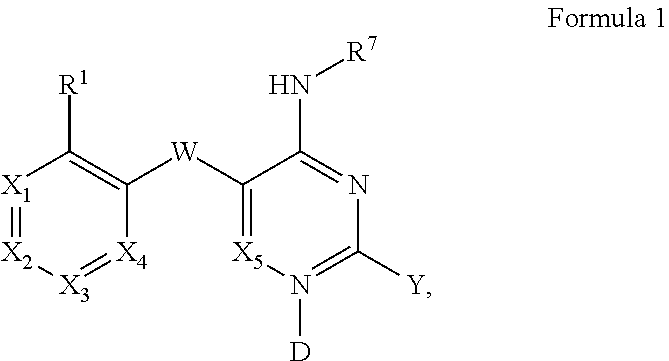Pyrimidines and variants thereof, and uses therefor
- Summary
- Abstract
- Description
- Claims
- Application Information
AI Technical Summary
Benefits of technology
Problems solved by technology
Method used
Image
Examples
example 1
of Compound 1
[0370]Compound 1 was made by the synthetic method outlined in Scheme E:
General Procedure for Preparation of Compound i-22: To a solution of compound i-21 (2.0 g, 7.6 mmol, 1.0 eq) and potassium difluoro(isopropenyl)borane fluoride (4.5 g, 30 mmol, 4.0 eq) in toluene was added K2CO3 (3.16 g, 22 mmol, 3.0 eq) and Pd(dppf)Cl2 (558 mg, 763 μmol, 0.1 eq) at 25° C. under N2. The mixture was heated to 100° C. and stirred for 12 h. The reaction mixture was directly concentrated under reduced pressure to give a residue. The residue was further purified by column chromatography eluted with petroleum ether: ethyl acetate to give compound i-22 (1.6 g, 6.4 mmol, 90% TLC purity) as a solid, which was used directly in the next step.
General Procedure for Preparation of Compound i-23:
[0371]A mixture of compound i-22 (1.6 g, 7.1 mmol, 1.0 eq) in MeOH was hydrogenated under H2 (50 psi) with catalyst Pd / C (100 mg) at 25° C. for 12 h. The mixture was filtered through celite, washed with met...
example 2
of Compound 2
[0379]Compound 2 was made by the synthetic method outlined in Scheme F:
General Procedure for Preparation of Compound i-29:
[0380]To a solution of 2-bromo-4-fluoro-1-nitro-benzene (60.0 g, 273 mmol, 1.00 eq) in the mixture of dichloromethane (400 mL) and methanol (440 mL) was added 1 M NaOH aqueous solution (1.00 L). Then a catalytic amount of TBAB (tetrabutylammonium bromide, 360 mg, 1.26 mmol) was added. The reaction was stirred at 40° C. for 16 h. The reaction mixture was partitioned between DCM and water. Then the aqueous layer was extracted with dichloromethane (3×300 mL). The combined organic layers were dried over Na2SO4, filtered and concentrated under reduced pressure. The crude product was purified by column chromatography on silica gel to give compound i-29 (43.1 g, 186 mmol) as a solid. 1H NMR: (400 MHz, Chloroform-d) 8.00 (d, J=9.3 Hz, 1H), 7.23 (d, J=2.6 Hz, 1H), 6.93 (dd, J=2.6, 9.3 Hz, 1H), 3.90 (s, 3H).
General Procedure for Preparation of Compound i-30:
[0...
example 3
of Compound 3
[0395]Compound 3 was made by the synthetic method outlined in Scheme G:
[0396]Compound i-37 was prepared as outlined above in Example 2.
General Procedure for Preparation of Compound i-38:
[0397]A mixture of i-37 (200 mg, 689 μmol, 1.00 eq) and sulfurochloridic acid (802 mg, 6.89 mmol, 458 μL, 10.0 eq) was stirred at 20° C. for 2.5 h. Then SOCl2 (164 mg, 1.38 mmol, 99.9 μL, 2.00 eq) was added. The mixture was stirred at 20° C. for 1 h. The mixture was used for the next step directly without work up and purification.
General Procedure for Preparation of Compound 3:
[0398]Compound i-38 was added to a cooled solution of NH3 (10 mol / L, 1.38 mL, 20.0 eq) in THF (1.38 mL) slowly at 0° C. The reaction mixture was stirred at 20° C. for 12 h. The mixture was filtered and washed with CH3OH (30 mL). The filtrate was concentrated and the residue was purified by prep-HPLC to give Compound 3 (37.0 mg, 100 μmol) as a solid. 1H NMR: (400 MHz, DMSO-d6) 7.87 (s, 1H), 7.22 (s, 1H), 7.06 (s, 1H...
PUM
| Property | Measurement | Unit |
|---|---|---|
| Temperature | aaaaa | aaaaa |
| Temperature | aaaaa | aaaaa |
| Temperature | aaaaa | aaaaa |
Abstract
Description
Claims
Application Information
 Login to View More
Login to View More - R&D
- Intellectual Property
- Life Sciences
- Materials
- Tech Scout
- Unparalleled Data Quality
- Higher Quality Content
- 60% Fewer Hallucinations
Browse by: Latest US Patents, China's latest patents, Technical Efficacy Thesaurus, Application Domain, Technology Topic, Popular Technical Reports.
© 2025 PatSnap. All rights reserved.Legal|Privacy policy|Modern Slavery Act Transparency Statement|Sitemap|About US| Contact US: help@patsnap.com



